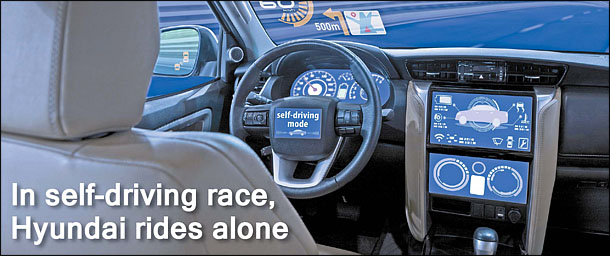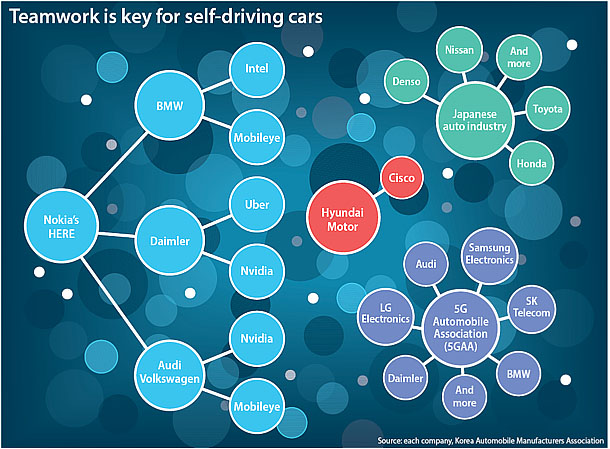In self-driving race, Hyundai rides alone

BMW, a leader in the business, is sharing resources with Intel and Mobileye. Daimler is working with ride-hailing service Uber, which is also collaborating with Volvo to share its latest self-driving technology. Audi and Nvidia are partnering and Google is working with Fiat Chrysler Automobiles on self-driving technology in minivans.
Japanese carmakers are also getting in on the game.
Toyota joined forces with Microsoft and Honda is in talks with Google’s parent company Alphabet.
The cooperation also extends to German rivals like Mercedes-Benz, BMW and Audi, who are teaming to co-develop mapping technology, one of the key factors for self-driving cars, by acquiring Nokia’s map business Here. Carmakers including Toyota, Nissan, Honda and auto electronics makers such as Denso and Panasonic signed an agreement last year to compete with U.S. and European rivals.
“Autonomous driving can never be achieved alone,” says Lee Hang-ku, a senior researcher at the Korea Institute for Economics & Trade. “It is an extremely sensitive and complex technology. Collaboration is mandatory because it takes down the possibility of failure and also reduces costs while speeding up the development pace.”
Amid a flurry of cross-industry partnerships, however, Hyundai Motor Group, the nation’s largest automaker and the world’s fifth by sales, is still reluctant to open up to external business entities.
Since Hyundai set a mission of releasing Level 4 self-driving cars by 2020 and commercializing a completely driverless car by 2030, the auto giant has had just two major partnership announcements.

Samsung and LG, which also joined the autonomous car race, have joined the global association known as 5G Automotive Association with 33 members, including mobile carrier SK Telecom.
“Partnerships among domestic players are weak which could jeopardize Korea’s competitiveness in future car technology,” said Kim Pil-soo, an automotive engineering professor at Daelim University.
Traditional carmakers need more advanced technology embedded in its vehicles to maintain their competitiveness in the fast-evolving industry.
Revenue from original equipment manufacturers or those associated with traditional auto manufacturing used to account for more than 70 percent of the industry in 2015. However, the share is expected to decline to 64 percent by 2030, according to a report from consulting firm PricewaterhouseCoopers.
Instead, new entrants associated with connected mobility such as new technology and software will take a larger portion of the pie to account for more than 45 percent or $3.5 trillion.
IT and network firms such as Nvidia and Mobileye are looking to capitalize on the trend.
Nvidia, a U.S.-based tech firm which used to build microchips and graphic cards for computer games, has branched out to the auto industry in recent years.
It is now one of the leading players in the future mobility business, collaborating with Tesla, Mercedes-Benz, Audi and Baidu to source its artificial intelligence-based computing system in their vehicles.
Analysts say commercializing autonomous cars takes more than just churning out auto parts made of ultra-high strength steel and assembling them flawlessly, which determined the quality of traditional vehicles.
“The autonomous vehicle is the culmination of cutting-edge technology in all sorts of industries,” said Kim from Daelim University. “Excelling in one sector will never be enough to make a self-driving vehicle. After all, the car has to make a decision for itself.”
Yet, Hyundai Motor and its sister company Kia Motors, which together account for more than 60 percent of domestic car sales, are building fences around its 50-or-so affiliates, maintaining the go-it-alone strategy it established five decades ago.
Vertical integration within the group affiliates that enables producing its own steel plates and auto parts and assembling them with machines that are their own is actually one of the driving factors that propelled Hyundai to the top tier of the global automotive market.
It reduced costs, while raising its effectiveness.
“With autonomous driving, such a system is obsolete. Traditional auto parts and assembling them together don’t add value. Value of software equipment is much higher,” said Lee of the institute.
Analysts say it won’t be easy for Hyundai Motor to do away with that type of management style.
Bureaucratic corporate culture such as the outdated top-down way of doing business and the authoritarian way of setting schedules for working hours is preventing the carmaker from preemptively adapting to the new paradigm.
“Hyundai Motor is not used to sharing technology and receiving feedback from others. Or maybe they don’t feel the need to,” said one analyst.
Hyundai Motor’s first tangible outcome regarding future mobility was a demo of its Tucson iX in 2010. Five years later, it demonstrated a partially self-driving Genesis in metropolitan Seoul on a 3-kilometer (1.9-mile) course. This year, it successfully demonstrated a Level 4 self-driving Ioniq model at the Consumer Electronics Show in Las Vegas.
Yet some say it is hasty to conclude that all is well with Hyundai Motor’s future mobility technology. “Forming an alliance or striking a partnership is possible when a company owns its own competitiveness that can contribute to the group’s member,” said Lee from the research institute. “Hyundai Motor is yet to have that kind of exclusive technology which is coveted by other global players,” he added.
After all, the Lidar sensors, key components in a self-driving car, are imported. Technology to develop highly sensitive sensors doesn’t exist in Korea.
It is clear that Hyundai considers autonomous vehicle technology a key segment. After all, it’s a market that is set to sell 21 million vehicles yearly by 2035, according to IHS Automotive.
Instead of openly collaborating with others, Hyundai chose to reorganize itself. In February alone, it unveiled two new major research center reorganizations to ramp up its future mobility technology. It integrated two research centers in Namyang, Gyeonggi, that had been separately dedicated to autonomous driving technology into one under the name Intelligent Safety Technology Center. Lee Jin-woo, who previously worked for General Motors’ equivalent research lab in Detroit, was appointed as the center’s head. Just a week later, Hyundai announced a plan to establish a research center devoted to developing future mobility technology in Uiwang, Gyeonggi.
The investment and human resource size put into what’s labeled Strategic Technology Research Institute hasn’t been unveiled, but the automaker pledged to focus on developing ICT, new materials and robotics. It also vowed to pursue open innovation where it will collaborate with universities and research centers.
“Hyundai is collaborating more than before, but it is not enough,” Professor Kim said. “More active teamwork among domestic and overseas players is a prerequisite in this business.”
BY JIN EUN-SOO [jin.eunsoo@joongang.co.kr]










with the Korea JoongAng Daily
To write comments, please log in to one of the accounts.
Standards Board Policy (0/250자)